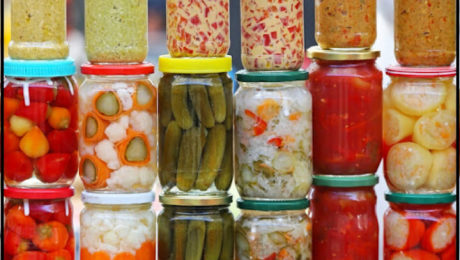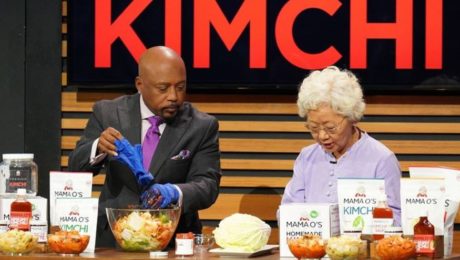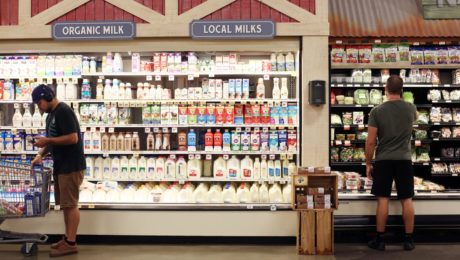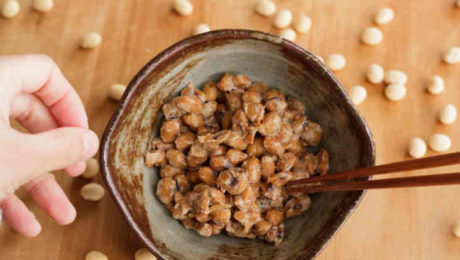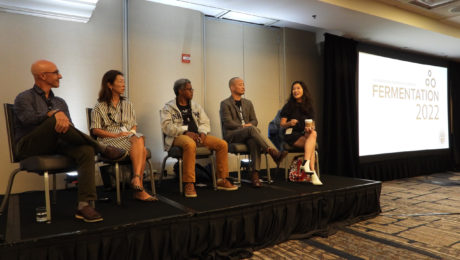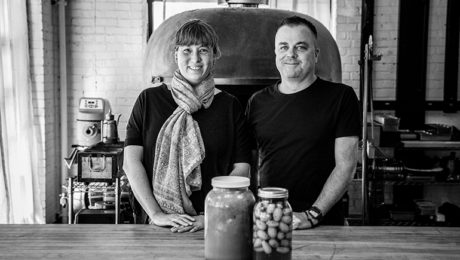Fermented Foods Reduce Stress
Researchers have made a breakthrough discovery in stress management: fermented food can change one’s mood.
Scientists from the University College Cork (UCC) APC Microbiome research center found consuming 2-3 servings of fermented foods a day – like sauerkraut, kefir, kimchi, kombucha, yogurt, etc. – improves mental health. Stress and depressive symptoms are reduced when regularly consuming fermented foods.
Their month-long study analyzed the effects of a psychobiotic diet on adults, while the control group was given general nutrition advice in line with the food pyramid. The psychobiotic diet is designed to target the gut microbiome. It includes fermented foods, fruit and vegetables high in prebiotic fibers, grains and legumes.
“Although the microbiome has been linked to stress and behavior previously, it was unclear if by feeding these microbes demonstrable effects could be seen,” said Professor John Cryan, one of the study’s lead authors, vice president for research and innovation at UCC, and a principal investigator at APC Microbiome. “Our study provides one of the first data in the interaction between diet, microbiota and feelings of stress and mood. Using microbiota targeted diets to positively modulate gut-brain communication holds possibilities for the reduction of stress and stress-associated disorders, but additional research is warranted to investigate underlying mechanisms.”
Researchers studied participants with relatively low fiber diets, measuring their perceived levels of stress before and after beginning the psychobiotic diet. Four weeks in, participants reported a strong decrease in perceived stress. Their sleep improved, too. Forty chemicals were affected by the change,
“These results highlight that dietary approaches can be used to reduce perceived stress in a human cohort. Using microbiota-targeted diets to positively modulate gut-brain communication holds possibilities for the reduction of stress and stress-associated disorders,” the study reads.
Cryan, in an article for The Telegraph, said: “The mechanisms underpinning the effect of diet on mental health are still not fully understood. But one explanation for this link could be via the relationship between our brain and our microbiome (the trillions of bacteria that live in our gut). Known as the gut-brain axis, this allows the brain and gut to be in constant communication with each other, allowing essential body functions such as digestion and appetite to happen.
“It also means that the emotional and cognitive centres in our brain are closely connected to our gut.”
He added: “The next time you’re feeling particularly stressed, perhaps you’ll want to think more carefully about what you plan on eating for lunch or dinner. Including more fibre and fermented foods for a few weeks may just help you feel a little less stressed out.”
The study was published in Molecular Psychiatrry.
Shark Tank’s Blunder
Fans are upset after investors on Shark Tank turned down a deal on Mama O’s Premium Kimchi. The exposure, though, netted some big sales for the Brooklyn-based fermentation brand.
Founder Kheedhim Oh and his mom Myung Oh appeared on the show’s 14th season, which aired in October. Oh pitched an investment of $250,000 for 10% equity in the company. But none of the five sharks – four who had surprisingly never tasted kimchi – took the deal. Though kimchi is exploding in popularity in the U.S. (sales increased 90% last year), it illustrates that education is still needed for kimchi to achieve mainstream acceptance in the American market.
“Honestly, I thought they would be more hip to what is actually going on in the world and the wave that fermented foods is having,” Kheedim (a TFA Advisory Board member) said in an interview with TFA. “I was generally just surprised about the lack of general knowledge or interest in fermented foods. The show has made my mission even stronger to help people eat a more Korean diet with kimchi being an important part of it.”
Despite their rejection of the first fermented food to appear on the show, Kheedim said Mama O’s received a nice sales bump from the show. After the show aired, Mama O’s netted four months of business sales in seven days. There was another bump in sales after supermodel Bella Hadid shared on Instagram stories how disappointed she was that the sharks passed on Mama O’s.
“I’m very grateful to Shark Tank because it was a great opportunity to help demystify making kimchi at home using the Mama O’s Homemade Kimchi Kit,” he added.
On the segment, Kheedhim shared his story of beginning the Mama O’s brand with just $50 and a skateboard. Today, Mama O’s sells various kimchi flavors, kimchi paste, kimchi sauce and the make-your-own kimchi kit. Eight years since launching, Kheedim has never used outside investors, always putting his own profits back into the business. Sales were $815,000 in 2021 and will reach an estimated $1 million in 2022. The sharks were impressed with the profits. It costs the company $2.65 a bag to make the kimchi, but it retails for $8.99. The wholesale kits cost $8.25 to make, but sell for $20.
Kheedim – who had to sign an NDA so can’t provide many details about the process – told TFA that he spent months perfecting the pitch, but the live Q&A did not go as smoothly as he wanted. He accidentally handed out his Super Spicy kimchi variety for sampling instead of the classic, milder flavor. He was planning to use the money to hire a production manager, increase broker coverage and fund the brand’s move this month to a larger production space in Queens, New York.
Still, the show has been excellent exposure for Mama O’s. In addition to the sales bump, Mama O’s followers on social media increased and individuals and companies continue to reach out to Kheedim with business opportunities.
During the episode, Kheedim told the sharks how “kimchi is a health food but more importantly it tastes incredible and not just with Korean food either” like hamburgers, hot dogs and mac and cheese.
“What’s makes our kimchi the best is our authentic korean mom recipe,” Kheedim told the sharks.
Kheedim’s mom, Myung, 81, was a fan favorite. She shared how kimchi is an ancient superfood from korea, “naturally fermented and it is full of probiotics.” She also detailed how proud she is of her son, for being an “honest, hardworking entrepreneur who is passionate about kimchi.”
Ultimately, the sharks shared different reasons for not investing. Mark Cuban said he’s concerned Kheedim has been investing his own money back into the company. Lori Greiner says she loves kimchi but found Mama O’s “not investable.” Kevin O’Leary said, though he sees kimchi thriving in the health food space, “the hardest part of this is going to get people to actually try it.” Daymond John admitted he wasn’t “obsessed” with kimchi. Kendra Scott said she didn’t know what kimchi was.
Fans were not pleased. They took to social media to voice their opinion.
“Many entrepreneurs come and go, but only some define the season. What a positive spirit to the pitch. Wishing you all the success.” @umang.thareja
“You should have got the money. They are fools!” @lifebettergreen
“Sharks made a HUGE mistake by not investing. More people in America just need education on kimchi. You guys are going to kill it. Mama O was amazing.” @s.andersn
The day after airing, Kheedim made an Instagram post with the Anthony Bourdain quote: “Americans want kimchi. They want it on their hamburgers. It’s like when Americans started eating sushi. A huge tectonic shift. That funk. That corruption of the flesh. That’s exactly the flavor zone that we are all heading towards.”
Of note: in 2018 during the show’s second season, the sharks did invest in the Kombucha Shop, a DIY kombucha-making kit.
- Published in Business, Food & Flavor
Educating Consumers About Fermentation
Fermentation continues to top food trend lists, health movements and restaurant menus, influencing more curious consumers to buy fermented foods. But the average consumer remains fermentation clueless.
“Fermentation is a really complicated subject and we’re just reaching the tip of the iceberg at this point when it comes to the research,” says Jenna Mills, account manager at Eat Well Global, a food and nutrition consulting agency. “A complicated subject like this is loaded and I feel that individuals and consumer know just enough to be confused.”
Five food professionals shared their thoughts on how to educate consumers about fermentation during a panel at FERMENTATION 2022. Panelists included: Mills, Shannon Coleman (associate professor and state extension specialist at Iowa State University), Matt Lancor (CEO and founder of Kombuchade), and Kirsten Shockey (author, educator and co-founder of The Fermentation School and TFA Advisory Board member). Amelia Nielson-Stowell, editor at The Fermentation Association, moderated.
Simple Messaging
The panelists agreed fermentation brands need to stop overcomplicating fermentation to the consumer, focusing on simple communication strategies.
“I compare it to a small child asking where babies come from – a simple answer is enough,” says Shockey. “With fermentation, often, we’re ready to say that lactic acid bacteria come in and they’re eating carbohydrates and there are these metabolites and flavors involved. We’re ready to share all the details – and we’re met with a blank stare. People just often want to know what’s the difference between a pickle and a ferment.”
Shockey, who teaches at the women-run Fermentation School, says she’s felt pressure over the years to innovate her classes and teach new subjects. But, especially since the Covid-19 pandemic when more consumers focused on health and turned to fermentation, her most popular classes are still the basic fermentation 101.
In a TFA survey last year, 70% of fermentation producers said a greater understanding of fermentation and familiarity with the flavors associated with fermentation would foster increased consumption of fermented foods.
Kombuchade is taking a unique approach to that education component, focusing on kombucha as a recovery drink.
“I’m looking to make probiotics cool for athletes, much like Gatorade made electrolytes cool for athletes,” Lancor says. The science of food is typically a mechanical process: eat fats, carbohydrates and proteins for optimal energy and performance. “There’s actually a microbial fermentation process that’s helping to rebuild your muscles.”
Kombucha marketing is geared toward a yoga, enlightenment crowd, Lancor adds, only reaching a certain number of consumers. It doesn’t resonate with all consumers.
“The south side of Chicago guys that play on my rugby team, they were never going to grab that kombucha bottle off the shelf with that kind of messaging,” he says. “There wasn’t this message of probiotics can be used for performance or recovery or even understanding kombucha’s place within an athlete’s regimen.”
Communicating Science & Tradition
Fermented food brands are tasked with bridging the gap between science and consumer.
Consumers keep informed about food and nutrition trends through professional associations (69%), academic (67%) and dietitians and nutritionists (62%), according to a consumer insights survey by Eat Well Global.
For 77% of consumers, the advice of dietitians and nutritionists impacts which foods they buy. Mills says healthcare professionals offer that counseling on how to incorporate fermented foods into the diet.
Don’t forget the ancestral wisdom, Shockey points out.
“My one liner is we’ve evolved with these foods and you are here because your ancestors successfully fermented,” she says. Rather than educating that people should eat a tablespoon of sauerkraut a day to meet nutrition needs, “try to bring it into your world naturally.” Eat a mixture of ferments, with yogurt at breakfast or hot sauce at lunch and kimchi at dinner.
“We cannot put ferments into this box that must be eaten raw. That to me is a barrier. You should eat this in any way that feels right to you,” she says, adding ferments were traditionally eaten cooked in soups and stews. “But in our minds right now is the idea that we have to eat our probiotics raw. These foods have so many metabolites that are being created in production and they follow through in the cooking process.”
Challenges to Starting a Brand
Starting a fermentation brand can be an overwhelming task. Sandor Katz, fermentation author and educator, said in his keynote address at the FERMENTATION 2022 conference that education is a huge challenge for people launching new fermented products.
“They often end up putting a lot of their energy into educating consumers,” he says.
Coleman says state extension offices are an underutilized resource for new producers. Her office got into food preservation after noticing many Pinterest recipes that gave poor advice on food safety.
“Just about every extension program has some form of food preservation type of program that they are delivering to consumers and they want to help,” Coleman adds.
There are no universal standards for labeling, an obstacle for new producers.
“Labeling is such a sensitive issue because you can get into big trouble with the FDA,” Nielson-Stowell says, pointing out the U.S. Food & Drug Administration only has 12 approved health claims a brand can put on a label. “It also gets tricky putting ‘probiotic,’ ‘prebiotic’ or ‘postbiotic’ on a label. It’s not regulated and confusing to consumers.”
The International Scientific Association of Probiotics & Prebiotics (ISAPP) is pushing for -biotics to be a more protected term. According to ISAPP, only fermented food brands with a scientifically measured -biotic should but it in a label. Their health benefits must be documented. For example, yogurts often have defined probiotic strains on their labels.
Nielsen-Stowell recommends using “live cultures,” “live microbes” or “naturally fermented” instead. And make sure retailers know what that means.
“If you’re getting your set in store with a retailer, the retailer will be your biggest advocate. The retailer is going to be the one talking to the customers more than you. Educate them. Do they know why your product is better than your competitor’s product?” she adds.
PBS Features HEX Ferments
Baltimore-based HEX Ferments was the star of the PBS show START UP. The series highlights small American business owners, chronicling what it takes to start a successful business.
During the episode, HEX Ferments co-founder Maegan Carpenter schooled START UP host Gary Bredow on ferments and gut health. She explained how the modern gut microbiome has been eroded by antibiotics, but fermented foods help to populate and repopulate the digestive system with good bacteria.
“What you’re getting essentially is a vegetable that’s been fermented in a blanket of bacteria that’s indigenious to our bodies: lactobacillus,” Carpenter explained, while Bredow sampled HEX’s seasonal Spirit Berry kombucha and Pizza Kraut sauerkraut.
A former art professor, Carpenter and her co-founder husband Shane, a former wedding photographer, never planned to start a fermentation business. Carpenter began teaching people how to use produce from their local community garden, offering tastings of the vegetables she fermented. Orders for her ferments started showing up in her mailbox. Carpenter said she thinks the demand came from “being open with people and showing people something that has been taken out of our culture for so long.”
Bredow added about modern food convenience: “It’s scary to think about if that convenience goes away, are we going to have a society of people incapable of watching food rot right in front of them.” Carpenter responded: “I think we already do.”
HEX Ferments will be expanding into a new, larger retail space later this year, HEX Superette. The space includes a kombucha taproom, small restaurant area to serve small plates, space to teach education classes and a local food marketplace. HEX Superette, Carpenter said, will “answer the question, ‘How do I eat this?’ because after 10 years of making fermented foods, we often get that question.”
Bredow concluding the episode noting that fermentation was born out of food scarcity, something today’s generation did not understand until the Covid-19 pandemic.
“Our ancestors planned for the future knowing that self sufficiency can mean the difference between life and death. Maybe it’s time to revisit the skills that allowed past generations to live with less fear and reliance on a system that always seems to be on the brink of collapse,” Bredow said. “I love what Meghan and Shane are doing. They’re not only offering up tasty and healthy foods, they’re reminding us how important it is to learn this lost craft before it’s too late…they’re offering fermentation classes. To me, this really is purpose. A focus on doing well and doing good for the world around them.”
- Published in Business, Food & Flavor
Pass the Protein Powder – and the Ferments?
Fermented foods can aid in muscle growth.
“A growing body of research suggests gut-friendly foods enhance muscle growth and could even take a bite out of age-related decline,” reads an article in Men’s Health.
As we age, the body slows down, reflexes decrease and muscle mass decline — especially difficult changes for professional athletes. The average person loses 5% of muscle mass per decade after reaching 30, leading to diminished mobility and heightened risk of falls. Exercising consistently is key to keep muscles strong. But equally important, research shows, is maintaining a healthy gut microbiome. New research – published in the journal Nutrition and Metabolic Insights – found mice with an artificially depleted microbiome from antibiotics had significantly slower muscle growth than the control group.
“In short, muscles really are built in the kitchen – at least, to a greater degree than you might have suspected,” the article continues.
The article points to the ground-breaking Stanford study that found a diet high in fermented foods boost microbiome diversity. The article concluded with four fermented food swaps “to make your gains last.” These include: swapping yogurt for kefir, swapping green beans for natto, swapping pickles for kimchi and swapping ketchup for miso.
Read more (Men’s Health)
- Published in Business
Promoting Fermentation Innovation
Several obstacles prevent the innovation of fermented foods, from the lack of scientific research to a chasm between science and industry to improving the sustainability of traditional ferments.
A third of foods consumed worldwide are fermented, totalling 3,500 products. A group of European scientists is studying how those fermented foods can drive innovation in food systems.
“There’s not a clear way to improve the unique properties of traditional fermented foods using microbial organisms,” says Vittorio Capozzi, PhD, a researcher with the Institute of Sciences and Food Production (ISPA) in Italy. “We still need innovation in traditional fermented foods.”
Capozzi was one of the presenters at a side event during the October Food & Agriculture Organization of the United Nations Science and Innovation forum. PIMENTO hosted the session. PIMENTO (which stands for “Promoting Innovation of ferMENted fOods”) launched last year in Europe, a project of the European Cooperation in Science and Technology (COST). PIMENTO aims “to place Europe at the spearhead of innovation on microbial foods” by promoting fermentation’s health, diversity and production. To achieve this goal, five working groups are structured around different fermentation topics. The groups are made up of both scientist and non-scientist fermentation experts studying and eventually implementing their findings.
Traditional ferments have “an important part of biodiversity that we cannot neglect,” Capozzi says. Fermentation provides new microbial-based solutions for a variety of foods, from plant-based ferments to alternative proteins. Innovations can improve nutrition and sensory qualities.
“In this way we are preserving biodiversity that has huge potential in biotechnology, science and innovation,” he says.
Ferments, he notes, can be protected. For example, a ferment produced in a specific geographical region (tequila in Mexico), a protected diversity, vegetable type, animal product or the human behavior used in production (Salers cheese in France).
“Fermented foods have been shaped through the centuries,” says Effie Tsakalidou, professor at the Agricultural University of Athens in Greece. “We have a lot of diversity.”
One of PIMENTO’s tasks is to create a database on European fermented foods. This list would include food types, production, consumption volume, technological parameters and legal status (like certifications).
Speaking on the health benefits and risks of fermented foods, Smilja Todorović, PhD, a professor at the Institute for Biological Research in Serbia, notes there’s a dearth of reputable, peer-reviewed studies on fermented foods.
“One of the very important things is to identify gaps in scientific evidence regarding benefits and risks,” she says.
The current studies on fermented foods are few and limited. Research does prove consuming fermented foods is correlated with overall mortality, decreased risk of diabetes, certain cancer types, high blood pressure and cardiovascular diseases. Todorović says that’s not enough.
“Unfortunately, when we look at scientific evidence to claim health properties, we can see that there are insufficient evidence. So all we have is a growing scientific interest in fermented foods and their impact on human health. However, we need to move from promising results to scientific evidence,” he says.
PIMENTO’s working groups are cataloging fermented foods’ impact on the gastrointestinal symptom, allergies, immunity, bone health and neurological projects. They also plan for projects studying fermented foods bioactive compounds, vitamin production and functionality; and fermented foods use in personalized diets.
The lack of studies prevents innovations in the field. Antonio del Casale, co-founder and CEO of Microbion, an agro-industrial microbiology company, says there is a disconnect between the scientists studying fermented foods and fermented food producers. He calls it “a valley of death.” The research on fermented foods is low, but the development of commercial resources are increasing.
“The problem is how to avoid the limitations of developing the food in this sector,” he says.
Traditions of Fermentation, Cultural Appropriation & Diversity
Cooking isn’t limited to only making the dishes of one’s ethnicity. The cultural identity of that food becomes murky when it gets transactional. Commercializing a food without respecting and honoring its history and tradition is inauthentic, damning to immigrant producers and threatens to erase traditional foods.
“Someone with more power or dominance, they can create their own kimchi – that doesn’t have any resonance to its tradition – and get it on the shelves of Wal-Mart and make it commercially successful. I don’t have that opportunity because I’m a woman, I’m Korean, I’m a minority and I’m just trying to tell the story about kimchi in my way,” says Lauryn Chun, founder and CEO of Mother-in-Laws kimchi. Chun’s kimchi comes from her mother’s recipe used in the family restaurant in California, Jang Mo Jip. “It’s my heritage of food that I enjoy sharing with Americans.”
Chun’s experience is similar to many BIPOC producers. It’s difficult for minority producers to compete with the white-owned brands that often have more money to launch a food company and receive preferential treatment by retailers for store placement.
“When you turn it into a business and you’re profiting as a company, we need to be more sensitive and more deliberate in how we give credit to people,” adds Robert Danhi, chef and co-founder of Flavor360 Solutions (and a TFA Advisory Board member)
Speakers discussed the wide range of issues related to traditional foods in a panel during TFA’s conference FERMENTATION 2022 titled “Traditions of Fermentation, Cultural Appropriation and Diversity.” Panelists included Chun, Danhi, Beverly Kim (chef and owner of restaurants Parachute and Wherewithall in Chicago), Kheedim Oh (founder of Mama O’s Premium Kimchi and TFA Advisory Board member) and Ismail Samad (founder of Loiter and Wake Robin Foods). The discussion was moderated by Josephine Wee (assistant professor at Penn State University and a TFA Advisory Board member).
Do Cultures Own Their Foods?
“There’s appropriate appropriation,” says Oh, whose Brooklyn-based kimchi brand is also based off the recipe of Oh’s mother, a Korean American. “Some of these brands, is what they’re making even kimchi? Kimchi is such a popular buzzword now. But it’s an unfair advantage when you’re competing with me and Lauryn to get your kimchi on the shelf and it’s very loosely kimchi.”
Brands are coming to retail with condiments labeled kimchi that are far from the traditional Korean condiments. They’re skimping on ingredients, like not using traditional Napa cabbage and opting for cheaper produce varieties. Though there’s hundreds of versions of traditional kimchi, some brands are veering too far to gain sales (Oh joked about a raspberry cheesecake kimchi).
“We need to change the narrative from appropriate to appreciation, celebration and preservation,” Wee adds.
Should a culture own a fermented food? Like Koreans just selling kimchi? The panel didn’t agree with that notion. But Samad points out a culture’s food is taken away from them when it’s exploited.
Through his nonprofit Loiter, Samad tackles the effects of systemic racial and economic injustice. He’s helping the residents of East Cleveland by developing successful, community-owned businesses – like Wake Robin Foods, a fermented food brand Samad purchased. Wake Robin will create ferments using produce from local, urban farmers.
“It’s black owned by black farmers so we can get some black dollars circulating in our culinary economy so they can have some freaking version of reparations for what has happened,” Samad says. “For me this is straight financial, who gets the opportunity to scale up.”
Samad says there’s an entire food system of African fermented foods “not being appropriated or appreciated in the U.S.” He hopes to disrupt the market.
“There’s an opportunity to introduce products that are owned by own by us, and by us I mean the African Diaspora,” he says.
Nuances in International Dining
Many American diners, though, are “still even at the elementary level of understanding the differences between different cultures in a diaspora,” says Kim, a former Top Contestant. “Asian cuisine is not just one monolithic cuisine.”
Some pan-Asian restaurants sell sushi (Japan) alongside kimchi (Korea) and pad thai (Vietnam), a “mish mash” of foods from different Asian countries. “We have to “continuously dig deeper to show there are nuances between the cultures,” she says.
It can be a difficult concept for chefs, too, who are trained in primarily French cuisine at culinary school. When Kim went through culinary school, a short quarter was focused on global foods, “the rest is basically Fresh cuisine.”
Ethnic food — especially Asian fare— the food is often stereotyped as cheap, “it’s a bamboo ceiling that you can’t charge high prices,” Kim says. Western diners often don’t take into account the differences in quality of ingredients or the creativity, care and time in cooking a dish. “We’ve been seen as cheaper because we’re Asian, so people question why our prices are so high.”
Chun, who grew up helping in the family’s Korean restaurant, began Mother-in-Law’s kimchi questioning why kimchi wasn’t in the ranks of specialty craft foods like fine cheese.
“From the perspective of western fermented foods, from cheeses to wines to craft beers, those are the only things people are willing to spend their money on,” Chun says. She adds she felt very proud to be the first kimchi in specialty grocery store chain Dean and Deluca.
In retail, many international food brands get placed in the ethnic aisle. But why does a sauce from an international region get placed in the ethnic aisle while spaghetti is placed in the sauces aisle?
“I’m torn over the concept of that existing,” Oh says. “We’ve been subjugated to the ethnic aisle aka the global ghetto where there’s no reason for it except the fact that I’m Korean.”
Cultural Regulatory Bias
Are there conflicts between tradition and science? Panelists shared how some health regulators don’t understand cultural ferments, causing batches of fermented food to be deemed unsafe for human consumption and thrown out.
Kim attempted to start a wholesale kimchi brand during the brand. Studies prove kimchi is made safely at a pH range of 4.2-4.5, but the regulator from the health department was told Kim legally had to keep kimchi under pH levels 3.3 to keep it safe.
“There’s so much confusion around it, I had to reach out to food scientists to clarify it, and we don’t want to get in trouble,” Kim says. She ended up cancelling the brand because securing regulatory approval was so difficult.
Oh adds: “I think there’s a big cultural bias when it comes to fermented foods. In the U.S., it’s either the food is 100% clean scrubbed and pasteurized or it’s not – and the not is dangerous and dirty. Where fermented foods predates modern electricity and modern science, there’s a reason why it’s safe because it works out that it’s a very safe food because, through the lactic acid fermentation, it lowers the pH and that helps preserve the food.”
- Published in Business, Food & Flavor
Reducing Waste, Cost with Fermentation
After hiring a fermentation expert to help reduce food waste, Id Est Hospitality Group saw their food cost drop from 32% to 22%. Kelly Whitaker, founder and chef, hired Mara King, fermentation specialist (both pictured), to pursue a zero waste model in the group’s different restaurants. Whitaker points out he doesn’t like using the term “waste” but “other products” instead.
King is chef, co-founder of fermented food business Ozuké, educator and producer of the YouTube series “People’s Republic of Fermentation.” She notes in a climate like Boulder, Colo., preserving food is key.
“As a fermenter, one of the first things Kelly wanted me to dive into was seasonality,” said King. “We live in Colorado and it has a short growing season compared to other places in the world.”
King began a large-scale preservation project at Id Est Hospitality Group, using the produce from local farmers to fuel ideas. For example, she made a vinegar using the discarded peels of 200 persimmons and a hot sauce with more than 90 pounds of 100 types of chiles, with the chiles prepared in different ways (preserved, roasted, frozen or dried).
Read more (Restaurant Hospitality)
- Published in Business, Food & Flavor
Upcycling & Zero Waste
Fermentation is a powerful culinary tool for upcycling.
During the Upcycling and Zero Waste session at FERMENTATION 2022, six fermentationists with diverse backgrounds in the industry shared how they’re using fermentation to reduce food waste.
“As a chef, we are constantly chasing these depths of flavors and things that you can’t get in regular cooking applications or techniques. Fermentation opened up a whole new world of flavor,” says Jessica Alonzo, a fermentation specialist and owner of small batch ferments company Native Ferments in Texas. “We were looking to enhance diner’s experience and fermentation did that.”
The panelists from all over the world included: Alonzo, Jeremy Kean (chef/owner of Brassica Kitchen), Mac Krol (CEO/founder of Mac Ferments), Richard Preiss (cofounder and brewing scientist at Escarpment Labs), Michelle Ruiz (CEO/co-founder of Hyfé Foods) and Ismail Samad (founder of Loiter and Wake Robin Foods).
Aiding farmers
Alonzo consults with area restaurants to build unique larders. She helped create the fermentation and whole food utilization program at Petra and the Beast as the former sous chef. Fermenting the restaurant byproducts helped the restaurant eliminate food scraps, cut down on food cost and partner with farmers.
Up to 40% of food grown in America is thrown away, according to the U.S. Department of Agriculture.
“I got into zero waste and upcycling through relationships with farmers, seeing how much was wasted at the farm level,” says Samad, who also co-founded and was executive chef at The Gleanery in Vermont. “The Gleanery existed for the last 12 years to provide a very clear safety net for farmers not selling their stuff at the farmers market.
Samad admits he didn’t know much about fermentation when he first started, “We just knew we didn’t want to keep wasting food.” By fermenting the kitchen scraps, “we’re making sacrifices that big food won’t do.”
Exploring Science
At a scientific level, Preiss at Escarpment is looking at upcycling “through a microbiologist lens.” Preiss said he began upcycling when he realized the current food system is unsustainable in a linear economy.
“There’s a lot of opportunity for creating circular food economies to not only reduce waste but help every single stakeholder involved in this process make more money, pay people more, create jobs, be more profitable and ultimately stay open as part of the sustainability discussion,” he says.
Restaurants are often leading upcycling and fermentation conversations – “many people know about fermentation because of restaurants.” But Preiss says the craft beer industry is becoming a leader in the upcycling movement because, today, they’re in many neighborhoods. “They have a really cool platform to communicate new ideas around food innovation.”
Escarpment is exploring interesting ways to use spent grains from beer. Currently, they’ve created a way to make seasonings. Brewers use those seasonings in their menu dishes, a novelty that gets customers excited about pairing a beer with a dish seasoned with that craft brew’s spent grain.
“There’s a lot of opportunity in that grain, there’s still a lot of nutritional quality,” Preiss says. “Through fermentation, we unlock new possibilities.”
Hyfé Foods is also utilizing waste. They’re taking the discarded sugar water (typically used in beverage production) and, through fermentation, repurposing it in mycelium flour. Mycelium is a type of mushroom. Hyfé’s proprietary biotechnology makes a protein-rich, low carb mycelium flour in a carbon-neutral, affordable process.
“Often when a manufacturer makes a product, the lifecycle being considered ends at the door. We’re often not measuring the greenhouse gas emission impact, the wasted sugar water – that goes down the drain,” says Ruiz. Food manufacturers pay a hefty fee to get rid of waste water. “We’re really excited about the position that upcycling puts us in, not only from a cost standpoint but also we’re creating a really nutritious, low cost food.”
Upcycling Barriers
Upcycling is not without its challenges.
Kroll at Mac Ferments specializes in koji. He recently created shoyu made with used coffee grounds, koji, water and salt – an excellent choice, he says, for a restaurant that likely throws out pounds of coffee grounds at the end of the night.
“It is obviously nice to create added volume from leftovers, it tightens the whole supply chain,” Kroll says. “But also there are risks of potentially overproducing just to create extra waste. You have to be careful what you’re doing because you’re dealing with enzymes – and we don’t see microbes.”
Fermentation, he says, should be utilized for quality, not quantity.
“If every dish has something fermented, a regular customer might come home starving,” Kroll adds.
Preiss sees collaboration as a major challenge because creating a circular, upcycled system involves multiple stakeholders sharing their waste products.
“Upcycling can’t be done in a silo, you need collaboration, and getting people that have the different pieces of the puzzle together to make it happen is the biggest challenge,” he says.
Samad, meanwhile, says scaling is a hurdle. “There are opportunities for investments around upcycling, but there’s a ceiling where this culture or ethos can be sustained.”
Educating customers, too, can be tricky. The public consuming the product or dish needs to understand what is upcycled. Servers, as the mouthpiece to diners, must taste and know a dish to communicate its elements. Chefs must detail to servers where ingredients were sourced, how long the food was aged and what was cross utilized, Alonzo says.
Panelists said the public is excited about the new taste experiences with upcycled food – but they’re also more curious about the science behind it.
“Folks come into Brassica for that fermentation program and are so interested and hungry for that knowledge from the science community,” Kean says. “And then theres folks that just want to eat and say ‘What the fuck was that?’ I think it’s a mixture between the two.”
“The education around all this stuff is growing,” he adds. “I see the culinary world and science world getting closer and closer together and I think that’s the right direction.”
- Published in Food & Flavor, Science
Inuit Scientist on Ferments of the Arctic
When Aviaja Lyberth Hauptmann, PhD, began her research into the metagenomics of snow and ice environments, she was surprised that plant-based diets were a constant focus in the field of human gut microbiome research.
“I wondered why no one seemed to acknowledge that some peoples, and in particular Arctic Indigenous peoples, have lived healthily off animal-source foods for millennia,” she says. “It was clear to me that there is a large gap in our understanding of how healthy animal-source foods affect the microbiome. And not just animal-source foods, but foods that are not industrially produced, foods that come straight out of our environment, including microbes from our environment.”
This has become central to Hauptmann’s research. She’s published two papers on Inuit foods. Her latest, on Inuit ferments, was published with Maria Marco, PhD, food science professor at University of California, Davis (TFA Advisory Board member). That study, published in the journal Microbiome Research Reports, concluded the way to “understand the value of these traditional animal-sourced foods” is to combine new microbiological techniques with projects led by the Inuit “who make and consume fermented foods.”
In an interview with Microbiome Research Reports, Hauptmann notes that most people consider the Arctic a harsh, barren and cold place. “But Inuit describe the vast sea ice as some might describe a garden. It is full of life and food. The Arctic is a source of diverse and abundant diets if one knows how to tap into the abundance and diversity, and an important aspect of that is food preservation and of course fermentation.” Inuit store meat and other food when it’s been abundant, so fermentation has played a central role for the last 300 years. She hopes Inuit people will still take part in that local culture, eating and preserving the local foods.
Read more (Microbiome Research Reports)
- Published in Food & Flavor, Science

